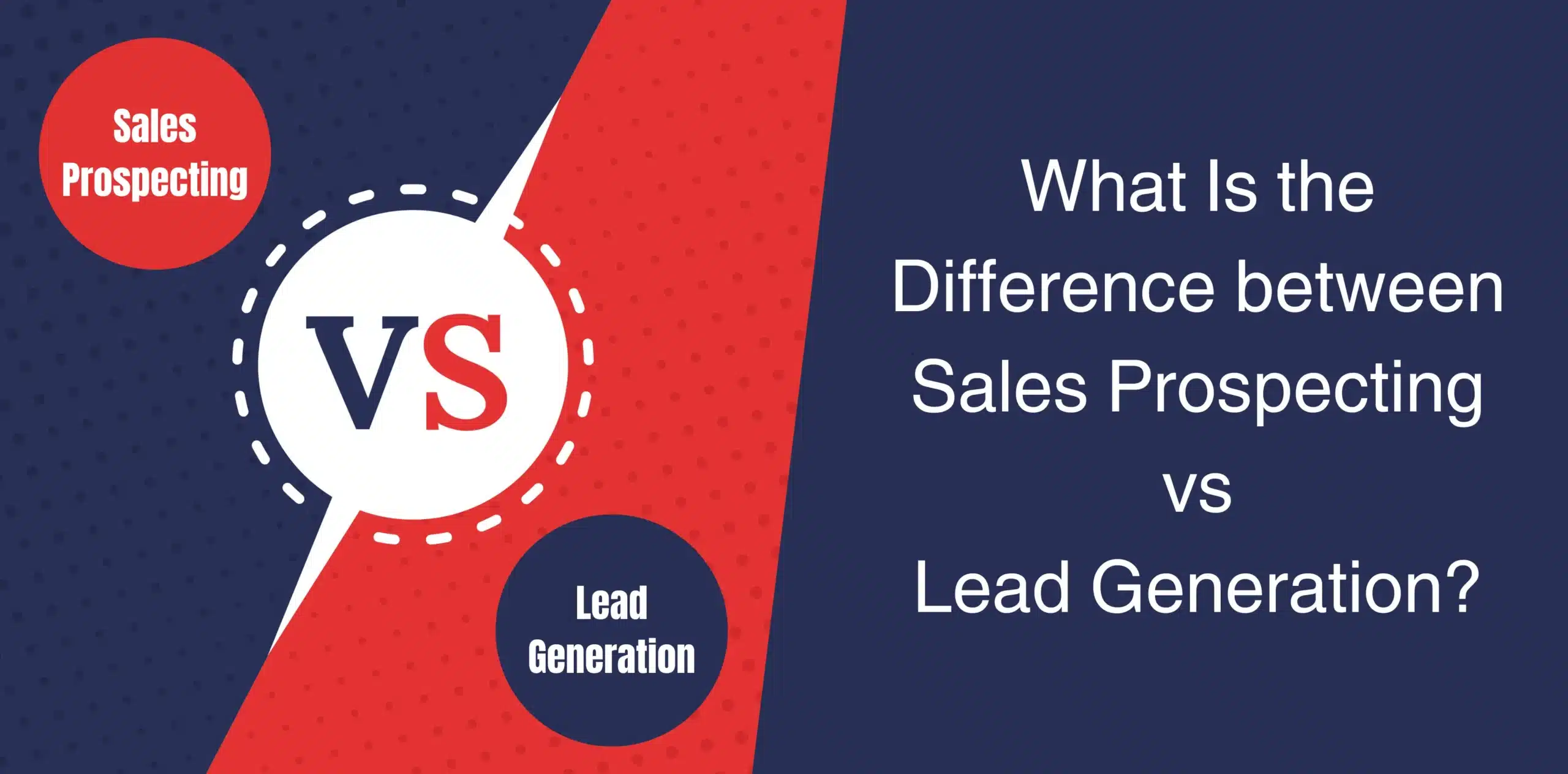Many people often think that sales prospecting and lead generation are two different names for the same process and can be used interchangeably. However, they aren’t the same. While they are interrelated and crucial components of the sales funnel, they have distinct roles.
We’ll compare sales prospecting vs lead generation, helping you understand the differences. We’ll also go over the challenges, strategies, and examples of sales prospecting and lead generation.
How Is Prospecting Different from Lead Generation?
Knowing the differences between lead generation vs sales prospecting is essential because it will help you create a better sales and marketing strategy. Even though the goal of both processes is to draw in potential customers, they function in different ways.
Sales Prospecting: A Proactive Approach

Sales prospecting is the process of identifying potential customers and initiating direct contact with them. This proactive strategy involves getting out and looking for people who may be interested in your product, service, or solution. The primary goal is to build a relationship as quickly as possible and move them toward a purchase.
In this strategy, your sales representatives actively search for potential customers using methods, such as cold calling, email outreach, networking, and social selling.
As you can see, the essence of sales prospecting is direct engagement.
This means your prospecting team should have a deep understanding of your target market, excellent communication skills, and the ability to build rapport as quickly as possible.
Lead Generation: An Inbound Strategy

Lead generation is more of an inbound marketing strategy, meaning the goal is to attract potential customers to your business or brand.
Under this model, instead of reaching out directly, you actually focus on creating content and campaigns to create awareness about your brand or product. It is a long-term approach that creates awareness, draws prospects in, and encourages them to try your product or service.
Unlike prospecting where the entire process is performed by your sales team, lead generation requires a holistic approach. It requires both your marketing and sales departments to work as a team to achieve their common goals.
The goal of lead generation is to capture the interest of potential customers and collect their contact information. This process often involves nurturing leads through LinkedIn, email marketing campaigns, and other touchpoints until they are ready to engage with your sales team.
Key Differences
So, here’s a quick summary of the key differences between sales prospecting and lead generation:
- Approach: Sales prospecting is an active, outbound approach where you directly contact potential customers. Lead generation is a passive, inbound strategy where you use valuable content and other tactics to draw prospects to your brand of business;
- Engagement: In sales prospecting, a salesperson usually starts engagement whereas in lead generation, a prospect already exposed to your marketing messages shows interest in your product or service and begins engagement;
- Timeline: Sales prospecting can lead to quicker engagement and conversion since it involves direct contact. Lead generation typically involves a longer timeline as prospects go through the nurturing process before they are ready to engage with sales;
- Personalization: Sales prospecting often involves a higher level of personalization as sales reps tailor their messages to individual prospects. Lead generation relies more on broad, targeted content that appeals to a wider audience;
- Measurement: The success of sales prospecting is measured by the number of meaningful interactions and appointments set with potential customers. On the other hand, lead generation’s success is measured by the volume and quality of leads captured through marketing efforts.
When to Use Each Approach
The choice between sales prospecting vs lead generation depends on various factors, including your business model, industry, and sales cycle.
Here are some scenarios where each approach might be more effective:
- Sales Prospecting: Ideal for B2B companies with high-value products or services, where direct, personalized outreach can significantly impact the decision-making process. It’s also effective in industries where potential customers are not actively seeking solutions or are unaware of their needs;
- Lead Generation: Suitable for businesses looking to scale their outreach efforts and attract a large number of potential customers. It’s particularly effective in industries where prospects actively seek information and solutions online, such as technology, healthcare, and professional services.
Biggest Sales Prospecting Challenges
Sales prospecting can be challenging in many different ways.
First, it’s time-consuming. Identifying the right prospects and reaching out to them individually requires significant effort and persistence.
Second, many prospects are inundated with sales messages daily, making it difficult for you to cut through the noise. Plus, it can be difficult to build trust and establish a connection through cold outreach.
Another major challenge is the high rejection rate in prospecting.
Many prospects are not immediately interested or ready to buy, which means you’ll face a lot of “no’s” before you get a “yes.” This can be discouraging, and maintaining motivation in the face of frequent rejection requires resilience.
Sales Prospecting Strategies
To overcome the challenges, you need a well-thought-out prospecting plan with robust strategies.
Here are some effective strategies you can include for your sales prospecting campaign:
- Research and Segment: Understand your ideal customer profile and segment your sales prospecting list accordingly. This can help you create a more targeted and relevant outreach;
- Personalize Your Approach: Generic messages rarely work so be sure to tailor your communication to address the specific needs and pain points of each prospect;
- Use Multiple Channels: Don’t rely solely on one method of contact. Instead, use email, phone calls, social media, and even in-person meetings to reach your prospects;
- Leverage LinkedIn: LinkedIn is an excellent platform for sales prospecting. Use Octopus CRM LinkedIn lead generation tool to identify and connect with potential prospects;
- Follow Up Consistently: Remember, persistence is key so you should try to follow up regularly without being too pushy. Sometimes, it’s the third or fourth touchpoint that gets a response.
Prospecting Examples
Here are some sales prospecting examples for your inspiration:
- Cold Calling: Contacting potential customers without prior interaction;
- Cold Email Outreach: Sending cold emails to potential customers to introduce your offering and start a conversation;
- Networking: Attending industry events, conferences, and trade shows to meet potential customers face-to-face;
- Social Selling: Using social media platforms, especially LinkedIn, to identify and engage with prospects through direct messages and content sharing.
Let’s say you want to sell software to small businesses. In this scenario, you can use LinkedIn to do prospecting for your software solution.
Here’s what you can do:
- Identify decision-makers on LinkedIn in the small business sector within your target industry;
- Send connection requests to the decision-makers, mentioning a common interest or a specific pain point they might have;
- Follow up with a message offering a free demo or a valuable piece of content, like a whitepaper, related to their industry.
These steps will help you build a connection and establish credibility, increasing the chances of turning a prospect into a lead.

How Is Lead Generation Different from Sales Prospecting?
While sales prospecting is proactive and direct, lead generation is about creating an atmosphere for prospects to come to you. This approach is more strategic and involves a mix of marketing and sales tactics. The goal is to attract and nurture potential customers until they are ready to engage with your sales team.
Biggest Lead Generation Challenges
Just like prospecting, lead generation comes with its own set of challenges.
One of the biggest hurdles is to create content that truly resonates with your target audience. With so much information available online, standing out and capturing your audience’s attention can be difficult.
Another challenge is to qualify your leads as effectively as possible.
Remember, not every lead that comes in will be a good fit for your product or service. For example, when it comes to generating leads on LinkedIn, it’s crucial to have a robust lead qualification process in place to ensure your sales team spends time on leads that are more likely to convert.
Lead Generation Strategies
Here are some strategies you might want to use for lead generation:
- Content Marketing: Develop informative and insightful content that directly addresses the pain points and interests of your target customers. Blog posts, eBooks, webinars, and videos are great ways to attract potential leads;
- SEO and PPC: Improve your website for search engines. Also, use PPC advertising to reach a larger audience and drive traffic to your landing pages;
- Social Media Marketing: Interact with your audience on relevant social media platforms, especially LinkedIn. Share content, participate in discussions, and use targeted ads to attract leads;
- Email Marketing: Develop a strong email marketing campaign to nurture leads. Provide valuable content and offers to keep them engaged and move them through the sales funnel;
- Lead Magnets: Offer something of value, such as a free trial, discount, or exclusive content, in exchange for contact information. This helps in capturing leads who are genuinely interested in your product or service.
Lead Generation Examples

While the above strategies are great examples of lead generation, below is an example showing how you can put a strategy into action.
Let’s assume you’re doing lead generation for a LinkedIn automation tool or service. Here’s how you can go about it:
- Publish a blog series on the benefits of LinkedIn automation and how to implement it;
- Offer a free eBook on improving marketing efficiency through automation;
- Run targeted ads on LinkedIn and Google to drive traffic to a landing page where visitors can download the eBook in exchange for their contact details.
When Prospecting and Lead Generation Work Together
Ideally, sales prospecting and lead generation should complement each other. When you integrate these approaches, you actually create a comprehensive strategy that ensures a steady flow of potential customers at different stages of the buying process.
For example, lead generation can fill the top of your sales funnel with interested prospects, while sales prospecting can help move these prospects further down the marketing funnel by engaging them directly and addressing their specific needs.
